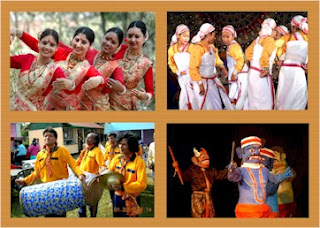Rituparno Ghosh-Jeevan Smriti
When Rituparno Ghosh was once asked which protagonist from his films he identified with the most, he had promptly responded naming Binodini from Chokher Bali. Although that film was his first directorial venture on Tagore’s work, Rituparno’s association with the bard goes long back, to his childhood days. Needless to say, Jeevan Smriti: Selected Memories, his docu-feature on the poet was bound to be quite different from any other documentaries made on the first Nobel laureate from India.
Throughout his life, and even in his death, Rituparno refused to play by the rules, creating new definitions of cinema with every film he made. By entering into Tagore’s personal space, almost like a voyeur in some scenes, Ghosh reinforces his uncanny style of filmmaking. Present throughout Jeevan Smriti as a passive observer, sometimes doubling up as a participant in the hustle-bustle of the activities at Jorasanko, the director effortlessly establishes himself as a member of the Tagore household. Ghosh easily builds an intimacy with Tagore, doing away with the distance one creates by putting the poet on a pulpit, akin to God.
Rituparno’s Tagore is like a mythical king who traverses alone, in disguise, among his subjects. Tagore, in this film is a seeker of the mystery of life in its sensuous form. His aura is complemented with the sobriety of his loneliness – one that produces music, paintings, literature and philosophy. Here Rabindranath Tagore stands out like a philosopher-king who is molten and made in the hearth of life.
Unlike other filmmakers, Ghosh delves into the inner world of Tagore, throwing light on his emotions as a kid, a young man and as a withering old human being. His sorrows, his misgivings, his losses, his worldview find a place in the film, chronicled like any other man. The fluidity with which young Rabi’s equation with his “notun bouthan” Kadambari is essayed, would invariably remind one of the nuances of platonic romance between Amal and Charu in Satyajit Ray’s adaptation of Tagore’s Nashtanir.
Although hailed as an abode of modernist ideas, Jorasanko Thakurbari had always held many secrets behind its closed doors. It is quite disappointing thus, that Ghosh didn’t take the leap to delve into this sea of secrets. Mostly sticking to the populist narratives on Tagore, Ghosh stops short of telling the unheard stories of the Thakurbari’s andarmahal. Delving into the hitherto unknown facts on Tagore’s life could have explored the lesser known stories. However, I wonder if he could have taken the liberty to make a radically different interpretation of Tagore, given that this was a government sponsored project.
Jeevan Smriti is not merely a docu-feature on a legend. It is an intimate tryst with a man who has been Rituda’s beloved. As a friend put it on a social media platform, the film presents Tagore’s limitless life like a palimpsest, and is interspersed with Rituparno’s own presence like that of an abhisarika who is overjoyed in trailing behind his lover with a diary in hand, as it were. He steps into Tagore’s world with a view to play a game of memory and imagination. The self-reflexive form of the film reminds one of experimental, biographical docu-features by cine-maestros like Mani Kaul. Thus the film remains a true cinematic tribute of Rituparno to his cultural mentors Tagore and Ray, like a suitable disciple.
From Chokher Bali to Chitrangada, Rituparno has always surprised his audience with his interpretation of Tagore. Jeevan Smriti could have been the beginning of a revolutionary phase in his filmmaking (He was planning to next adapt Kabuliawalah, in the context of the US invasion of Afghanistan and Taliban terror). Alas, we have to contend ourselves with only this life of memories.


.jpg)
Comments
Post a Comment